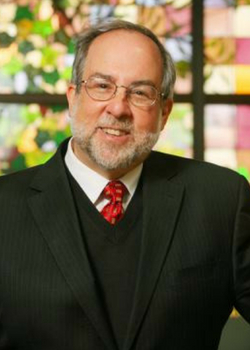An auto mechanic working on a new model car opens the Chilton manual to learn the car's specifications and directions for its repair. A therapist encountering an unfamiliar problem consults the Diagnostic and Statistical Manual of Mental Disorders. A tax accountant consults a stack of manuals detailing this year's deductions and allowances. Every profession has its "tech manual." Even rabbis. When I was ordained, I received the little black book with the words recited at the bris, under the Huppah, and at graveside.
A tech manual ensures the car is repaired properly, the proper remedy is prescribed, the tax return isn't flagged for an audit. The tech manual tells the professional how to perform a particular function. While there may be room for creativity and originality in the practice of a profession, the concern of the tech manual is to get the job done right. Its concern is purely procedural: What to do and how to do it. It doesn't say why. That's not the purpose of the manual. Tech manuals are useful; they're not deep.
The first eighteen chapters of Leviticus are essentially the tech manual for the ancient Israelite priesthood. The specifications of the sacrificial worship are spelled out in detail -- which animal is offered for which purpose in what way. Like any manual, the driving concern of Leviticus is technical. The Torah's term is "l'ratzon" (Lev 1:3-4) "do it right." Sacrificial worship, like auto repair and tax preparation, is highly technical, rule-bound, and articulated with meticulous specificity. The individuality of the worshipper or the creative flair of the presiding priest is not the concern, only the proper performance of the rite. And there is no explanation, interpretation or elaboration of the meaning of these rites, just a register of procedure.
Professionals typically keep their tech manuals hidden in their desk, or behind solemn black leather covers on their office bookshelves. This preserves the authority of the professional and the mystery of the professional domain. The determination to publish the priestly tech manual at the heart of the Torah - revealing it to the entire people - is a profound statement of spiritual democracy. It fulfills the promise "you shall be mamlechet kohanim -- an entire nation of priests" (Ex 19:6). Even in its most technical expression, this religion is not meant to be esoteric. It is not the secret, guarded domain of the initiated. And God is not remote. There is no exam or licensure separating anyone from addressing God. Not even priestly or rabbinic ordination. God is "near to all who call upon God, to all who call in truth" (Ps 145:18)
But there is a danger in exalting a tech manual. It encouraged an obsession with the technical details of performance of worship which allowed for spiritual vacuity and moral obliviousness. This is precisely what enraged the Biblical prophets. Worship became a species of tax-preparation -- a debt to be paid off with no particular sense of loyalty. The prophet Isaiah railed:
"What need have I of all your sacrifices?" Says the LORD.
"I am sated with burnt offerings of rams, and suet of fatlings, and blood of bulls; and I have no delight in lambs and he-goats.
You come to appear before Me— Who asked that of you?
Trample My courts no more!
Bringing oblations is futile,
Incense is offensive to Me.
New moon and sabbath, proclaiming of solemnities,
Assemblies with iniquity, I cannot abide.
Your new moons and fixed seasons fill Me with loathing;
They are become a burden to Me, I cannot endure them.
5 And when you lift up your hands, I will turn My eyes away from you.
(Isaiah 1:11-14)
"Who asked that of you?" That's a remarkable question after eighteen chapters of blood and animal parts in Leviticus. But the point is made: If the tech manual becomes the totality of faith, you have missed the purpose of worship. Too easily is religion reduced to ritual Jiffy Lube - regularly scheduled, technically precise, "auto service" - guaranteed in and out in ten minutes.
When the Temple was destroyed, the Rabbis imported the Leviticus tradition of a technical, rule-bound, articulated structure into the practice of Jewish prayer. Mishna Brachot is the tech manual for davening. Its first words signal this priestly attachment to technique: "From what time can the evening Shema be recited?" (Brachot 1:1) But within the Mishna's terse articulation of the rules, the spirit of Isaiah surfaces again. In chapter four, the rabbis debate the rules for the daily Amidah prayer. It's all technical: Rabban Gamliel requires a full recitation of all eighteen blessings. Rabbi Yehoshua affords leniency -- an abbreviated form of the prayer. For Rabbi Akiba, the requirement is relative to the worshipper's fluency. Then comes Rabbi Eliezer who explodes the whole discussion: "When worship is made keva -- fixed, routinized - it is no longer genuine prayer [aino tahnunim]." Worship rendered statutory is Jiffy Lube. Prayer must have structure, and worship form. But technically precise performance cannot become its totality. Isaiah would be proud.
The tech manual has it place. But occasionally, someone needs to come and burn it. What Isaiah did to Leviticus, and Rabbi Eliezer did to Mishna Brachot, the medieval masters of piyyut, the composer Solomono Rossi, the Hasidic tradition would come in their time and repeat. This is the historical process that grows our worship tradition. The cocoon must be shed so that the chrysalis may emerge and take flight. It continues today in the creative inventiveness of a thousand new expressions of Jewish prayer sprouting about us. This dance between the old and the new is our tradition. It is l'ratzon, it is the right way.

